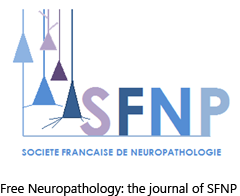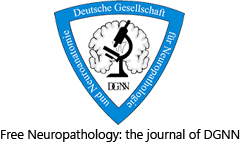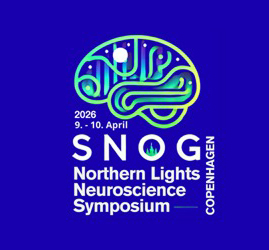Depletion of nuclear cytoophidia in Alzheimer's disease
DOI:
https://doi.org/10.17879/freeneuropathology-2025-6282Keywords:
Alzheimer’s disease, Cytoophidia, Phosphoribosyl pyrophosphate synthetase, Intranuclear rodlets, PurinesAbstract
There is considerable evidence for a role for metabolic dysregulation, including disordered purine nucleotide metabolism, in the pathogenesis of Alzheimer’s disease (AD). Purine nucleotide synthesis in the brain is regulated with high fidelity to co-ordinate supply with demand. The assembly of some purine biosynthetic enzymes into linear filamentous aggregates called “cytoophidia” (Gk. Cellular “snakes”) represents one post-translational mechanism to regulate enzyme activity. Cytoophidia comprised of the nucleotide biosynthetic enzymes inosine monophosphate dehydrogenase (IMPDH) and phosphoribosyl pyrophosphate synthetase (PRPS) have been described in neuronal nuclei (nuclear cytoophidia; NCs). In light of the involvement of purine nucleotide dysmetabolism in AD, the rationale for this study was to determine whether there are disease-specific qualitative or quantitative alterations in PRPS cytoophidia in the AD brain. Double fluorescence immunostaining for PRPS and the neuronal marker MAP2 was performed on tissue microarrays of cores of temporal cortex extracted from post-mortem tissue blocks from a large cohort of participants with neuropathologically confirmed AD, Lewy body disease (LBD), progressive supranuclear palsy, and corticobasal degeneration, as well as age-matched cognitively unimpaired control participants. The latter group included individuals with substantial beta-amyloid deposition. NCs were significantly reduced in frequency in AD samples relative to those from controls, including those with a high beta-amyloid load, or participants with LBD or 4 repeat tauopathies. Moreover, double staining for PRPS and hyperphosphorylated tau revealed evidence for an association between NCs and neurofibrillary tangles. The results of this study contribute to our understanding of metabolic contributions to AD pathogenesis and provide a novel avenue for future studies. Moreover, because PRPS filamentation is responsive to a variety of drugs and metabolites, they may have implications for the development of biologically rational therapies.
Metrics
Additional Files
Published
How to Cite
Issue
Section
License
Copyright (c) 2025 Alyona Ivanova, David G. Munoz, John Woulfe

This work is licensed under a Creative Commons Attribution 4.0 International License.
Papers are published open access under the Creative Commons BY 4.0 license. This license lets others distribute, remix, adapt, and build upon your work, even commercially, as long as they credit you for the original creation. Data included in the article are made available under the CC0 1.0 Public Domain Dedication waiver, unless otherwise stated, meaning that all copyrights are waived.



















